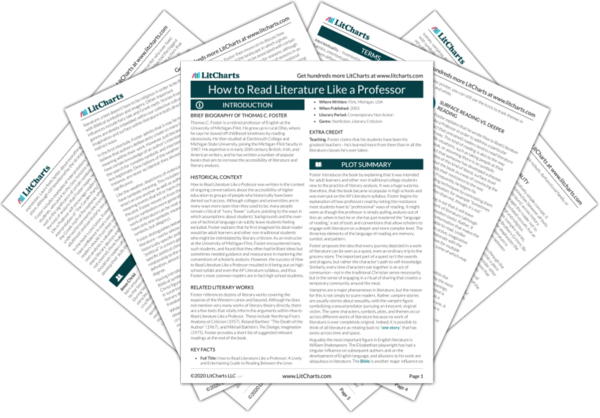Welcome to the LitCharts study guide on Thomas C. Foster's How to Read Literature Like a Professor. Created by the original team behind SparkNotes, LitCharts are the world's best literature guides.
Read Like a Professor: Introduction
A concise biography of Thomas C. Foster plus historical and literary context for How to Read Literature Like a Professor.
Read Like a Professor: Plot Summary
A quick-reference summary: How to Read Literature Like a Professor on a single page.
Read Like a Professor: Detailed Summary & Analysis
In-depth summary and analysis of every chapter of How to Read Literature Like a Professor. Visual theme-tracking, too.
Read Like a Professor: Themes
Explanations, analysis, and visualizations of How to Read Literature Like a Professor's themes.
Read Like a Professor: Quotes
How to Read Literature Like a Professor's important quotes, sortable by theme, character, or chapter.
Read Like a Professor: Characters
Description, analysis, and timelines for How to Read Literature Like a Professor's characters.
Read Like a Professor: Terms
Description, analysis, and timelines for How to Read Literature Like a Professor's terms.
Read Like a Professor: Symbols
Explanations of How to Read Literature Like a Professor's symbols, and tracking of where they appear.
Read Like a Professor: Theme Wheel
An interactive data visualization of How to Read Literature Like a Professor's plot and themes.
Brief Biography of Thomas C. Foster
Thomas C. Foster is a retired professor of English at the University of Michigan-Flint. He grew up in rural Ohio, where he says he staved off childhood loneliness by reading obsessively. He then studied at Dartmouth College and Michigan State University, joining the Michigan-Flint faculty in 1987. His expertise is in early 20th century British, Irish, and American writers, and he has written a number of popular books that aim to increase the accessibility of literature and literary analysis.
Get the entire Read Like a Professor LitChart as a printable PDF.

Historical Context of How to Read Literature Like a Professor
How to Read Literature Like a Professor was written in the context of ongoing conversations about the accessibility of higher education to groups of people who historically have been denied such access. Although colleges and universities are in many ways more open than they used to be, many people remain critical of “Ivory Tower” culture, pointing to the ways in which assumptions about students’ backgrounds and the over-use of technical language can subtly leave students feeling excluded. Foster explains that he first imagined his ideal reader would be adult learners and other non-traditional students who might be intimidated by literary criticism. As an instructor at the University of Michigan-Flint, Foster encountered many such students, and found that they often had brilliant ideas but sometimes needed guidance and reassurance in mastering the conventions of scholarly analysis. However, the success of How to Read Literature Like a Professor resulted in it being put on high school syllabi and even the AP Literature syllabus, and thus Foster’s most common readers are in fact high school students.
Other Books Related to How to Read Literature Like a Professor
Foster references dozens of literary works covering the expanse of the Western canon and beyond. Although he does not mention very many works of literary theory directly, there are a few texts that vitally inform the arguments within How to Read Literature Like a Professor. These include Northrop Frye’s Anatomy of Criticism (1957), Roland Barthes’ “The Death of the Author” (1967), and Mikhail Bakhtin’s The Dialogic Imagination (1975). Foster provides a short list of suggested relevant readings at the end of the book.
Key Facts about How to Read Literature Like a Professor
- Full Title: How to Read Literature Like a Professor: A Lively and Entertaining Guide to Reading Between the Lines
- Where Written: Flint, Michigan, USA
- When Published: 2003
- Literary Period: Contemporary Non-fiction
- Genre: Nonfiction, Literary Criticism
Extra Credit for How to Read Literature Like a Professor
Teaching. Foster claims that his students have been his greatest teachers—he’s learned more from them than in all the literature classes he’s ever taken.












